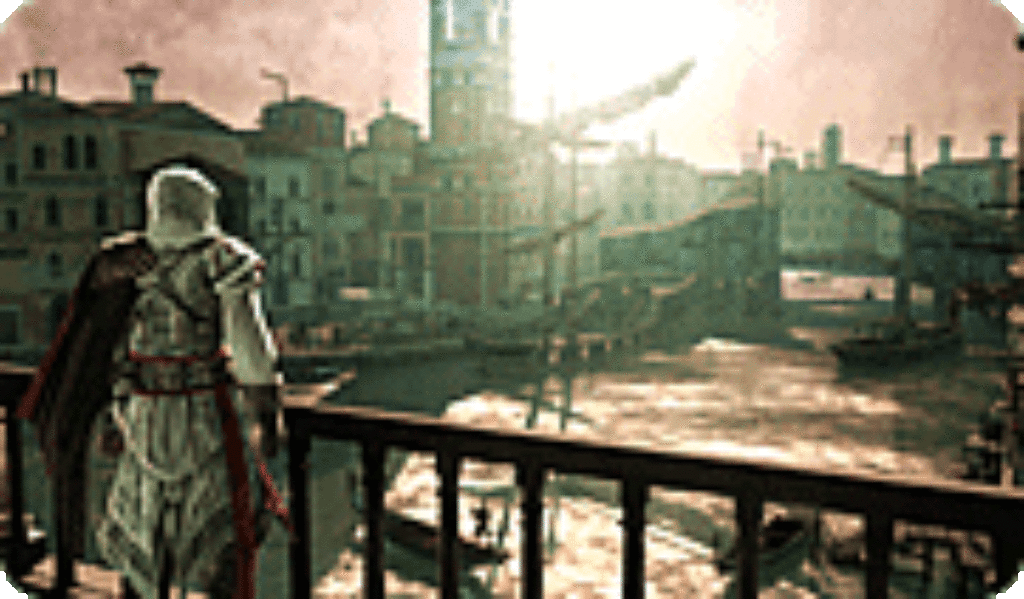
Assassin’s Creed II contains much of what made Assassin’s Creed an 8 million unit seller—lots of crowd-blending, wall-clambering, murderous missions. And then it adds in enough ancient intrigue and religious conspiracy twists to make Dan Brown wish he’d dreamed it all up for his next novel.
A Once and Future Killer
The first Assassin’s Creed features a bartender named Desmond Miles who is snatched off the street by modern masters of mayhem who are mysteriously connected to the ancient Knights Templar. They strap him into a fancy contraption that puts his DNA code on tap and digitally re-creates the genetic memories of his long-forgotten forebear.
This Crusades-era great-great-great-great-grandpa just happened to be an assassin who had dealings with some pretty powerful artifacts—treasures that the kidnappers want to find in the here and now. So if Desmond wants his life back, he’s got to slip on some bloody ancestral shoes and put together some clues.
The new Creed picks up the thread of Desmond’s plight right where it got cut off. The still bewildered bartender is given an assist to escape his original captors and then taken to the hideout of a group that wants to strike back against the Templars. Of course, to do that, Desmond must plug into their version of the DNA machine and jump back to yet another ancestor with assassin clan ties.
(Talk about a family tree full of rotten roots.)
So now Desmond’s running through Italy in the 1400s as Ezio Auditore. Young Ezio is more apt to climb in a lover’s window than creep up and stab somebody when we first meet him. But the betrayal and murder of his beloved family members soon sends him reaching for an assassin’s robe and blade. From there it’s all about uncovering traitors’ names and wreaking revenge, while still seeking out those treasured artifacts.
Striking From the Shadows
Players must develop acrobatic skills, leaping from rooftop to rooftop, and use shadows and crowds for protection when stalking a foe. An armory of swords, maces, throwing knives, pistols and a pair of deadly hidden blades slip easily beneath your hooded cloak. Finding ways to infiltrate a crowd and impale a target without drawing scores of opponents is a paramount proficiency.
New gaming developments include an improved notoriety system that heightens AI opponent’s suspicions, forcing more stealth. And it’s not just secrecy that’s elevated as Ezio’s renown ratchets up. Things can eventually get to the point where lining a town crier’s pocket or slicing a city official’s neck becomes “necessary” just to get the job done.
Blood sprays and soaks victims’ garments. A near-naked couple run and climb their way through one scene. (Circuitry-like coverings obscure full nudity.) In another, local courtesans draw attention with some exposed skin of their own. (The girls sport wispy outfits and reveal cleavage.) Foul language includes quite a few f- and s-words (in English and Italian), “b‑‑tard,” “h‑‑‑,” “b‑‑ch,” “d‑‑n” and “a‑‑.”
God Is in the Artifacts
The original Creed hinted that the “Piece of Eden” artifacts everyone is pursuing had some connection with and impact on biblical history. This sequel speaks much more plainly: Most of the Bible’s conflicts—from Adam and Eve’s struggle to Abel’s murder to Jesus’ crucifixion—are attributed to mankind’s desire for the godlike powers of these incredible relics.
Parallel to that idea is this one: There is no such thing as God. Thus, the corrupt and malicious Pope Borgia denies his Holy Father, saying that the Bible was written by men and therefore a lie, “like all religious tracts.”
A nun/prostitute muddies things up all the more by excusing her sleazy sexual activities as holy work. And if all of that isn’t Da Vinci Code enough, Leonardo himself shows up from time to time. He has no great works of art on hand, but the inventor proves himself to be quite handy at piecing together deadly weaponry.
Maybe he had assassins in his bloodline, too.

After spending more than two decades touring, directing, writing and producing for Christian theater and radio (most recently for Adventures in Odyssey, which he still contributes to), Bob joined the Plugged In staff to help us focus more heavily on video games. He is also one of our primary movie reviewers.